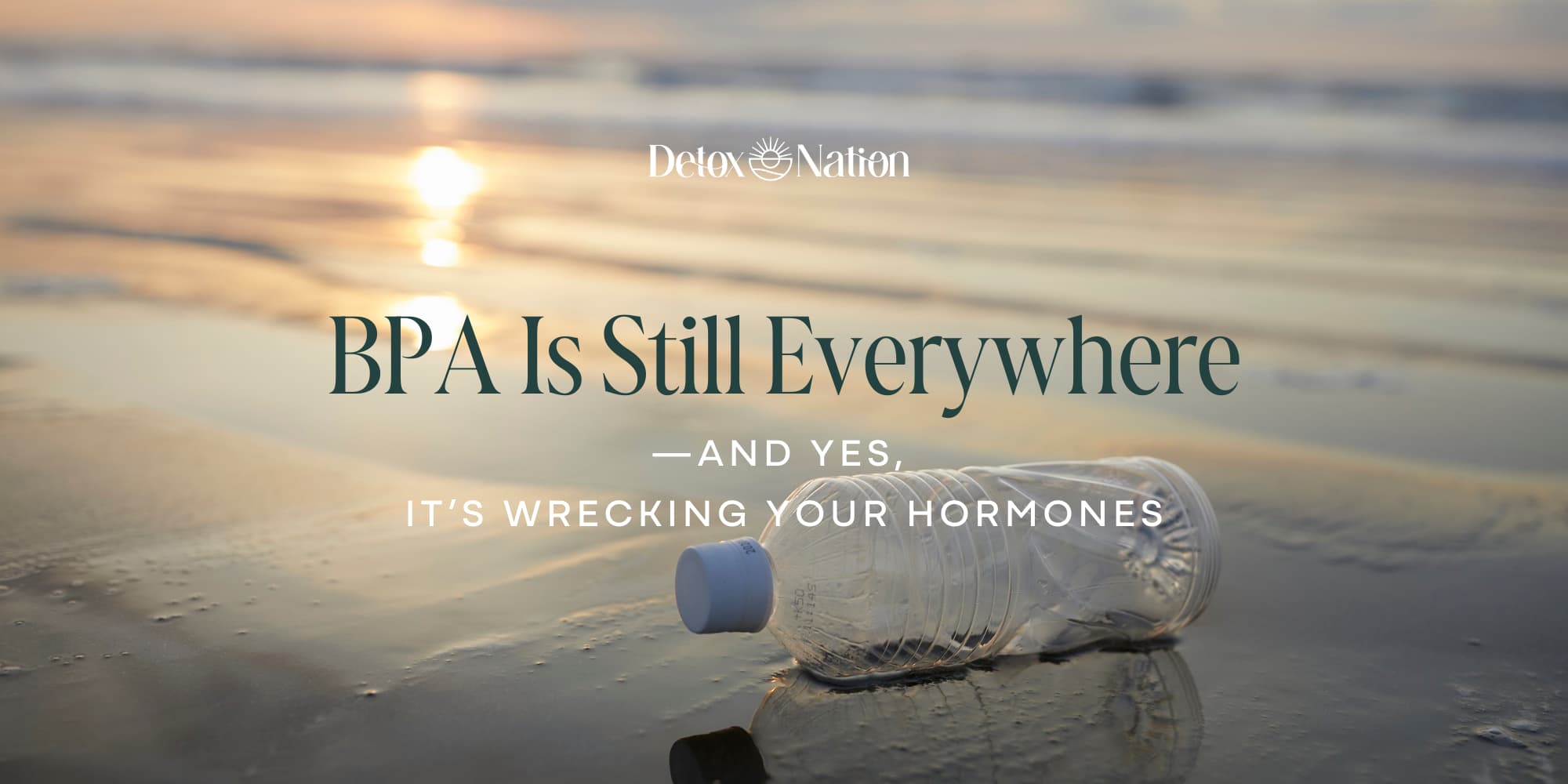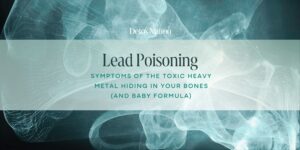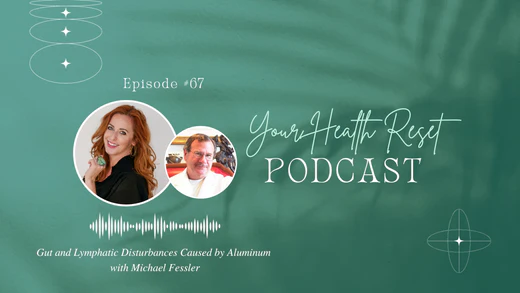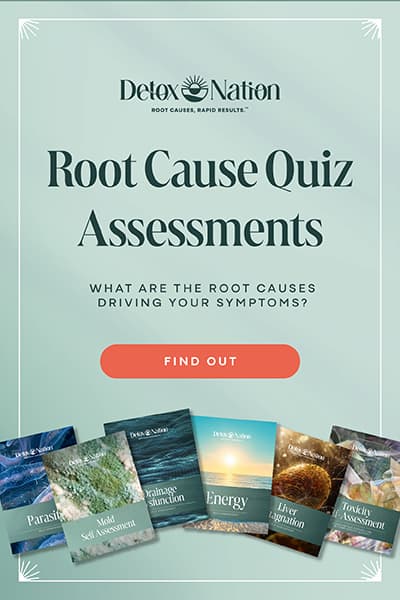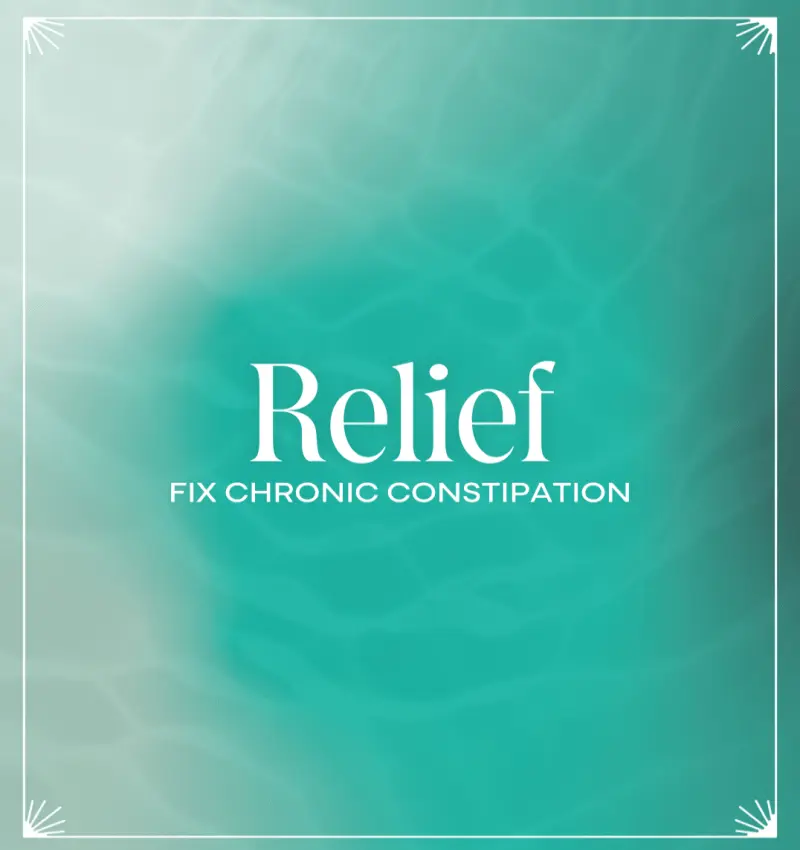Human exposure to bisphenol A (BPA) is stacking up. From brain fog to thyroid slowdown, BPA’s adverse effects on health are real, sneaky, and fixable (once you know where it’s hiding).
You’ve done your part.
You ditched the plastic water bottles, bought the glass meal prep containers, and yes—you even said no to those flimsy receipts at the checkout.
And still… your hormones are a mess, your energy is tanked, and your brain feels like someone swapped it for a sponge.
What no one tells you is that BPA—that infamous plastic chemical we all got warned about a decade ago—is still very much in the picture.
And it’s not just hanging out in your water bottle.
Here’s the part that gets me: most practitioners still aren’t talking about it. Not the way you need them to.
Because BPA isn’t just “an endocrine disruptor.”
And when you’re already dealing with chronic symptoms, even small exposures to BPA can be the thing keeping you stuck.
But once you understand how BPA works and where it hides, you can do something about it.
Let’s get started.
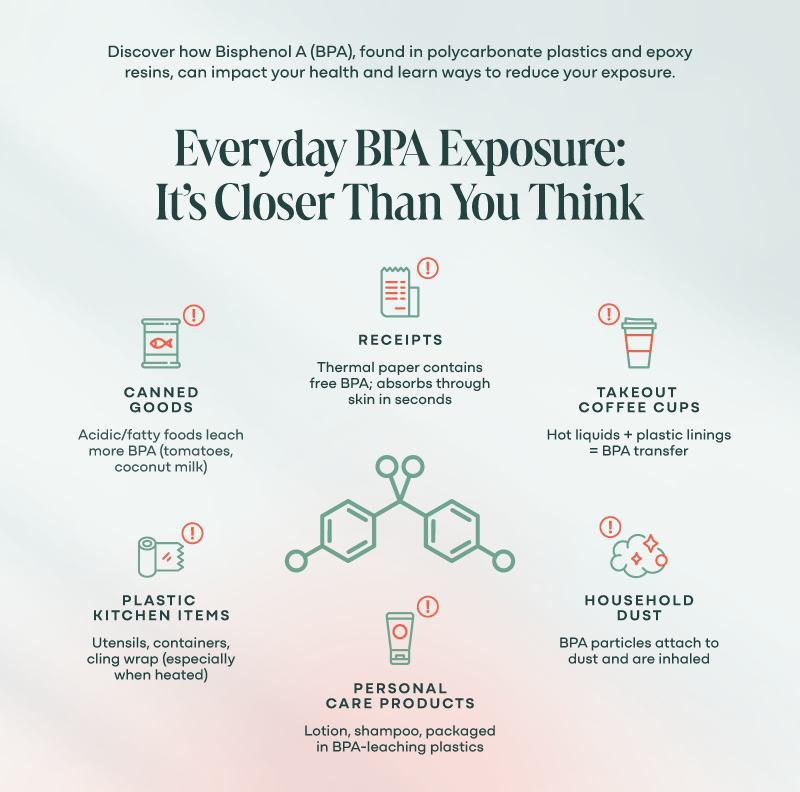
What Is BPA—and Why Should I Be Concerned About It?
BPA stands for Bisphenol A—a synthetic compound that was originally developed as synthetic estrogen. (Yes, you read that right. Your favorite takeout container started its life as a failed hormone drug.)
When the pharmaceutical world didn’t bite, chemists realized BPA made plastic strong, clear, and shatterproof. So, in the 1950s, it found a second act as the backbone of polycarbonate plastics and epoxy resins.
Today?
- More than 15 billion tons are produced worldwide every year (6, 7), much of it used in single-use packaging (9, 17).
- Over 1 million pounds / 100 tons leach into the environment annually (3, 7).
- In 2023, the European Food Safety Authority dramatically decreased the tolerable daily intake, making it 20,000 times lower than before (7, 21).
- It’s found in amniotic fluid, breast milk, cord blood, the placenta, blood, urine, saliva, bile, feces, fat tissue, sweat, and hair (3, 6, 7, 10, 16).
- Co-exposure with nanoparticles, industrial chemicals, and environmental toxins can increase bioaccumulation and toxicity of BPA (22).
Ready to Finally Get Answers?
Uncover your unique toxic burden (mold, metals, BPA & more) and build a plan around your results.
Book Your Free Call NowWhere BPA Is Hiding—and How It’s Getting Into You
If you’re picturing BPA exposure as “I drank from a plastic water bottle once in 2012,” think bigger. It’s not the occasional oops moment that’s the problem.
It’s the constant, low-level, body-confusing exposure that adds up over time—and chips away at your resilience (26).
Canned Food and Beverages (BPA in Food)
The inside of most cans of food are coated with BPA-based epoxy to prevent corrosion (3, 7, 13, 15, 16, 17, 22).
That lining leaches especially well into acidic or fatty foods—think tomatoes and anything coconut-based.
And yes, even some brands that brag about being “BPA-free” have quietly replaced it with equally sketchy substitutes like BPS and BPF, which may be even more hormonally disruptive (7, 12).
BPA in Food Packaging, Bottles, and Utensils
The most common cause of BPA accumulation in humans is food packaging materials and munching on contaminated foods (3, 7, 9, 12).
Worse? Heating + plastic = BPA party (3, 4, 6, 7, 10, 17, 20).
That microwave-safe Tupperware?
Not your friend.

Takeout Coffee Cups
Here’s the betrayal nobody talks about: your compostable, eco-chic coffee cup is often lined with a BPA-type plastic.
That piping hot oat milk latte?
It’s now infused with a little side of hormone disruptor.
Thermal Paper Receipts
Receipts are coated in free BPA that rubs right off onto your fingers and into your bloodstream (3, 6, 7, 16, 17, 22).
It only takes a few seconds of contact for BPA to absorb through your skin—especially if you have hand lotion, sanitizer, or sweat acting as a carrier.
(And no, hand-washing after touching a receipt doesn’t undo the absorption that already happened. Sorry.)
Personal Care Products and Household Dust
This one flies under the radar, but BPA has been found in makeup containers, shampoos, even some lotions—especially when stored in plastic (3, 6, 7, 13, 15, 17, 20, 22).
Over time, those plastics degrade, and tiny BPA particles end up in your product (and then on or in you).
Other Sources of BPA
- Water bottles (3, 7, 17, 20)
- Dental sealants (3, 6, 7, 10, 15)
- Electronics (3, 7, 15, 17)
- Toys (3, 6, 7, 17)
- Glasses (6, 7, 15, 17)
- Water supply pipes (3, 6)
- Kitchen utensils (3, 6, 17)
- Medical devices (3, 15, 17)
- CDs / DVDs (6, 15, 17)
- Sewage effluent and landfill leachate (17)
- Disposable face masks – During COVID, an estimated 4 billion masks were used daily: each containing up to 2 micrograms of BPA per mask (24).
It also clings to dust particles, meaning you can inhale BPA without even knowing it (7, 12, 15, 17).
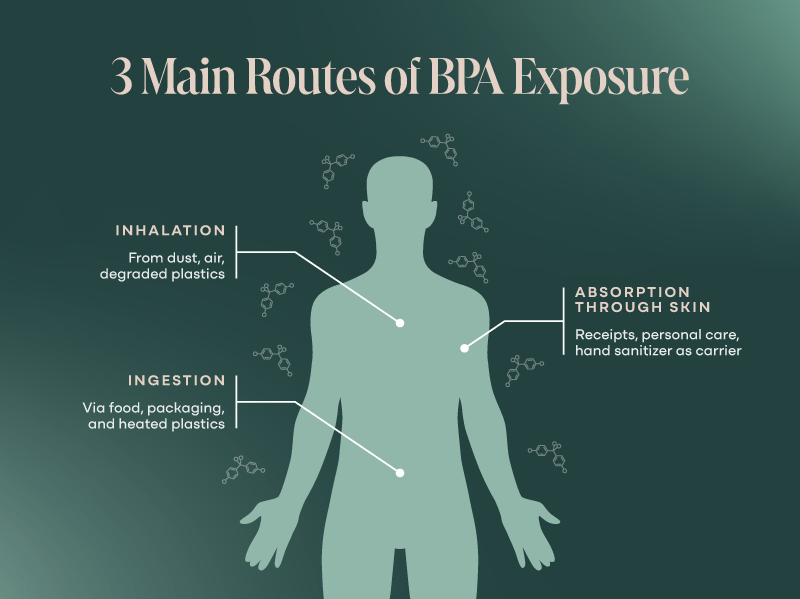
How Does BPA Actually Get Into You?
Here’s how this chemical ninja infiltrates your system:
- Ingestion – The #1 route. You eat or drink BPA-contaminated food and beverages (3, 4, 6, 7, 9, 12, 15, 17).
- Skin Absorption – Fast and efficient, especially from receipts and lotions (6, 7, 9, 12, 15, 17, 24).
- Inhalation – Dust, off-gassing from plastics, and industrial environments (6, 7, 12, 15, 17).
Your liver and kidneys try to filter it out, but when your detox pathways are sluggish, BPA gets recycled back into circulation or stored in fat and brain tissue (6, 17).
Yep. Your brain.
This is why it’s not just about avoiding the obvious offenders—it’s about understanding the system-wide implications so you can create real change.

Exposure to BPA Is Just the Beginning—Understanding the Exposome
Here’s a wild thought: what if your body isn’t broken—it’s just overwhelmed?
If BPA were the only thing we had to worry about, your detox pathways could probably handle it.
But BPA is just one piece of a much bigger puzzle called the exposome—the total of every toxic exposure you’ve ever had, from birth until now (and in some cases, even before that) (16).
Yes, even before you were born
Studies have shown that BPA crosses the placenta and has been detected in fetal tissue (1). Which means many of us entered the world already carrying a chemical burden that’s only gotten heavier with time.
Now layer in:
- Mold toxins from that apartment with the “musty” smell
- Mercury from old fillings or tuna lunches
- Pesticides from your lawn-loving neighbor’s weekend hobbies
- Phthalates from shampoo, fragrances, and plastic wrap
- Glyphosate from non-organic foods
- EMFs from… everywhere
This is the reality of living in a modern body in a modern world where environmental exposures contribute to 70-90% of all disease risk (16).
Your body isn’t just dealing with one chemical—it’s navigating thousands of them, interacting in unpredictable ways (22).
And the research shows that even low doses of these chemicals can have major effects when they show up together (26).
Unfortunately, most research, testing, and regulation happens one chemical at a time.
But that’s not how exposure works in real life.
BPA Doesn’t Travel Alone
The real issue isn’t just BPA. It’s BPA plus mold. Or BPA plus chronic stress and a dysregulated nervous system. Or BPA plus a sluggish liver that’s been doing overtime since college.
When you start seeing BPA as part of the larger exposome—not a random outlier—you stop blaming yourself for not “healing faster” and start working with your body instead of pushing against it.
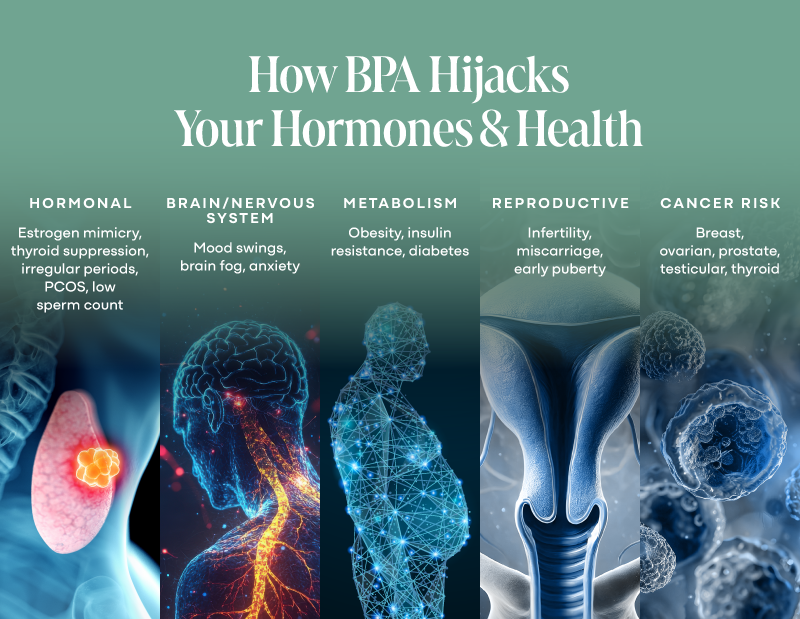
Potential Health Effects of BPA on the Endocrine System: Disrupting Your Hormones from the Inside Out
Let’s talk about your hormones. (Don’t worry, I’ll go first.)
BPA: The Estrogen Impersonator
BPA is what researchers call a xenoestrogen—a fake estrogen that tricks your body into thinking it belongs there (3).
Because BPA looks like estrogen to your body, it slips right into hormone receptor sites like it owns them.
This hormonal mimicry confuses your signaling pathways, hijacks your natural rhythms, and tells your body to behave in ways it was never designed to.
It’s like someone breaking into your house, putting on your clothes, and trying to live your life while your real self gets locked in the basement.
The result?
Mixed signals everywhere.
Your body thinks you’re producing enough estrogen, so it downshifts production… or worse, it adds more to keep up with the chaos.
And BPA doesn’t break down easily. Once it’s in your system, it lingers.
Because it’s fat-soluble, your body stores it in your tissues to “deal with later”—which often becomes never, unless you actively support your drainage and detox pathways.
Exposure to Bisphenol A and the Brain-Hormone Connection
Your hypothalamus and pituitary—those master hormone regulators in your brain—are especially sensitive to BPA.
They’re in charge of the feedback loop that keeps your reproductive, adrenal, and thyroid hormones in balance.
But when BPA’s pretending to be estrogen, the whole chain of command goes sideways.
Some Hormonal Impacts:
- Irregular or heavy periods (2)
- Fibroids, PCOS, or endometriosis (2, 6, 23)
- Fertility issues or miscarriages (2, 7, 15, 17)
- Lower sperm count and concentration (6, 12)
- Decreased cortisol (17)
- Ghrelin and leptin changes, impacting appetite and satiety (7)
- Increased fat / obesity (7, 12, 13, 16, 22, 23, 27)
- Every 1 ng/mL increase in BPA correlates with an 11% increased risk of obesity (13)
- Insulin resistance (4, 23)
Bonus Nightmare: BPA Use + Developing Bodies
Let’s not ignore the elephant in the preschool: BPA has been linked to fetal malformations, early puberty in children, abnormal breast development, and even changes in brain structure and social behavior in animal models (1, 3, 15).
Tiny bodies are more vulnerable, and their detox systems are still developing. This stuff matters.
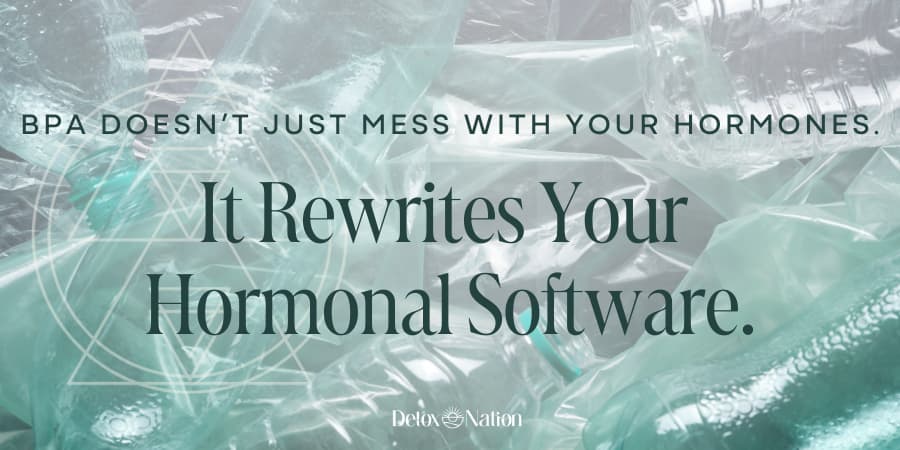
What the Research Actually Says About the Health Concerns
Let’s get nerdy for a sec:
- BPA is detectable in over 90% of U.S. adults—so if you’ve got symptoms, you’re not alone (7, 10).
- BPA increases inflammation (7, 9, 17, 18, 19), suppresses your immune system (17), and is associated with autoimmune diseases (7, 9, 26, 21, 26).
- BPA is associated with cardiovascular disease (7, 23), hypertension (18, 19, 23), lipid oxidation (7, 18, 19), stroke (3), and type 2 diabetes (7, 22, 23)
- BPA has been linked to mutagenesis and multiple types of cancer (6, 12, 15, 17, 22) including:
BPA doesn’t just “mess with your hormones.” It rewrites your hormonal software.
And that’s just one system it touches.
Next up, we’ll look at how BPA derails your mitochondria so you’re running on fumes.
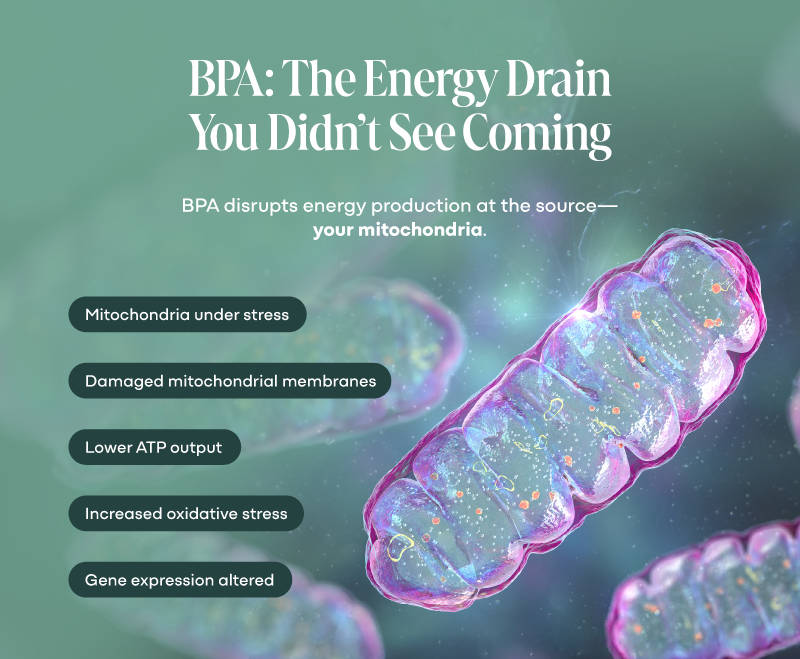
BPA and the Energy System: Why You’re Still Exhausted
You know that bone-deep fatigue that makes folding laundry feel like an Olympic sport?
Yeah, that’s not “getting older” or “just stress.” That’s mitochondrial dysfunction—and BPA plays a starring role.
Meet Your Mitochondria: Your Cellular Engines
Your mitochondria are tiny organelles inside your cells responsible for producing ATP—the energy currency pf your body.
They’re supposed to run smoothly, churning out energy like a clean-burning fire.
But throw BPA into the mix? You’ve just dumped sugar in the gas tank.
BPA Shuts Down the Power Plants
Here’s what the research shows:
- BPA interferes with your antioxidant system (18, 19, 22).
- BPA disrupts mitochondrial membranes, making them leaky and dysfunctional (9, 17, 19, 22).
- It lowers ATP production, meaning your body is literally generating less usable energy (9, 17, 19, 22).
- It can even alter mitochondrial gene expression, so your cells stop making energy the way they used to.
Translation? You’re tired because your cells are operating on dial-up in a 5G world.
And Just to Make It Spicier: Epigenetic Damage
BPA doesn’t just hurt your mitochondria today—it can reprogram them for dysfunction over the long term.
In some studies, BPA exposure has been shown to alter mitochondrial DNA in ways that can be passed on to future generations (1,7, 22).
This is part of why deep detox is no longer optional, it’s necessary.
You must interrupt the toxic chain reaction and give your body a real chance to repair itself.
And it can—once you get the junk out of the way.

Effects of Bisphenol A and the Nervous System: When Your Body Feels Like It’s Constantly on Edge
Let’s get one thing straight: your nervous system is doing everything it can to keep you safe in a world that feels increasingly unsafe—chemically, emotionally, energetically.
How BPA Messes with Your Nervous System
BPA is neurotoxic and crosses the blood-brain-barrier (3, 7, 9).
That protective gate between your bloodstream and your brain? Yeah, it waltzes right through.
Once inside, it doesn’t just hang out—it alters brain chemistry and electrical signaling (3, 6, 7, 22).
Here’s what we know from the science:
- BPA interferes with neurotransmitters like dopamine and serotonin, which regulate your mood, motivation, and ability to handle stress (3).
- It promotes neuroinflammation, which can make you feel anxious, depressed, or mentally foggy (1, 3, 9, 17).
- It disrupts synaptic plasticity—your brain’s ability to adapt, rewire, and learn (1, 3).
- High levels of BPA have been found in neurodegenerative diseases (3, 7), ADHD (3, 11), Autism (3, 11), schizophrenia (3), and bipolar disorder (3, 11)
And since your nervous system is the command center for literally everything it’s no wonder chronic symptoms pile up when it’s under attack.
Nervous System Dysregulation = Symptom Whack-a-Mole
Here’s what this might look like in your day-to-day life:
- Your gut’s unpredictable (BPA messes with the gut-brain axis, too) (7, 9, 16)
- You feel anxious but can’t figure out why (1, 3)
- Loud noises, smells, or bright lights make you want to crawl out of your skin
- You’re constantly bracing for the next stressor—and exhausted by all the bracing
And the worst part? You start to think you’re the problem.
Nope. You’re not broken. You’re just flooded.
BPA + Vagus Nerve = Total System Scramble
Let’s talk about your Vagus nerve—your body’s main parasympathetic (rest-and-digest) superhighway.
When it’s well-regulated, you feel calm, clear, resilient. You can digest your food, sleep deeply, and feel safe in your body.
But BPA can interfere with vagal tone, impairing communication between your gut, brain, and heart (28).
This keeps you stuck in sympathetic overdrive (fight, flight, freeze, or fawn), even if there’s no real “threat” in sight.
If your body keeps acting like the house is on fire when you’re just trying to make a grocery list… BPA might be whispering in your nervous system’s ear, “Panic now.”
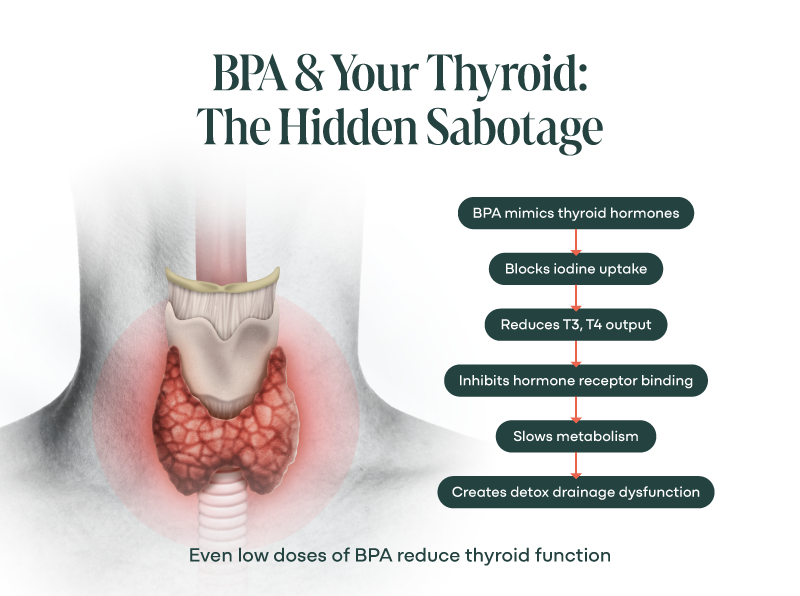
BPA and the Thyroid: The Slow Burn You Can’t Ignore
Let’s talk thyroid.
You know the drill:
- You’re exhausted no matter how much you sleep
- Your hair’s falling out in handfuls
- You’ve gained weight while basically eating air
So, you get your thyroid checked.
TSH and, if your doctor’s really generous, maybe they check T4. And then you hear it again:
“Everything looks normal.”
But nothing feels normal.
Here’s why: BPA disrupts your thyroid at every level—and unless you’re looking at full thyroid panels and root causes, it flies completely under the radar (9, 10, 21, 26).
BPA Mimics and Blocks Your Thyroid Hormones
Your thyroid hormones are like the internal thermostat for your whole body. They regulate metabolism, mood, temperature, digestion, and energy.
But BPA shows up to the party in disguise—it looks enough like a thyroid hormone to confuse your receptors, but not enough to actually do the job.
It’s like someone sneaking into your office, sitting in your chair, and refusing to answer your emails.
Even low doses of BPA cause:
- Reduced T3 and T4 production (the actual hormones your body needs) (21)
- Blocked receptor sites, so even the hormones you do make can’t land properly (10)
- Inhibited iodine uptake, which is crucial for thyroid function
Thyroid Dysfunction Creates a Toxic Feedback Loop
When your thyroid slows down, your liver and gallbladder get sluggish too.
That means your ability to detox BPA gets worse, which means more BPA builds up, which means even less thyroid function. See the problem?
This is why taking thyroid meds without addressing your toxic load can feel like a band-aid on a broken pipe.
To truly heal, we have to stop pouring BPA into the system and help the body clear what’s already there.
And guess what? That’s totally doable.
Check out this thyroid kit we put together to help support your thyroid!
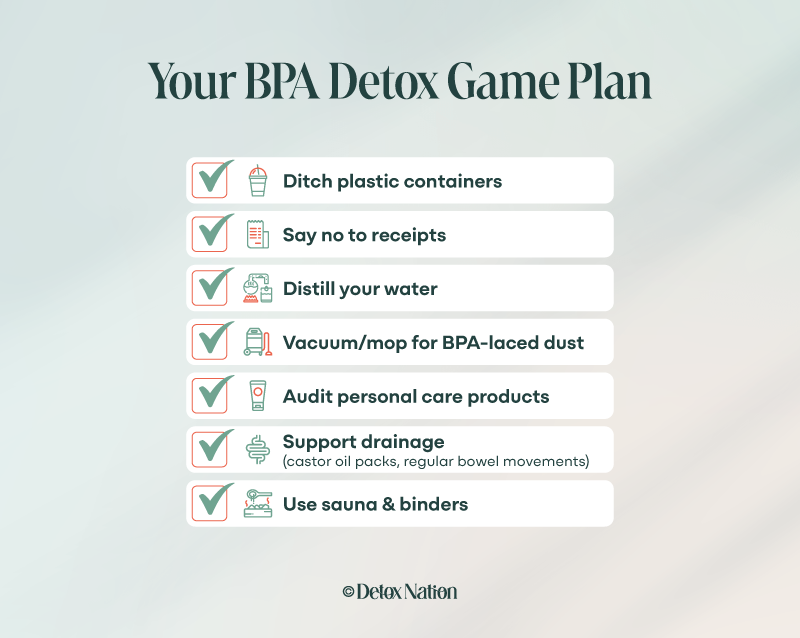
7 Steps to Get BPA (and Friends) Out of Your Life
Let’s be clear: you don’t need to become a hermit who only drinks dew off ferns and stores food in hand-thrown ceramic pots.
You just need a strategy to reduce your body’s burden enough that your systems can finally come back online.
Detox Your Kitchen—Like, Yesterday
Your kitchen is ground zero for BPA exposure. Assume all plastic is guilty until proven innocent.
- Ditch plastic containers, especially if you heat food in them (microwave, dishwasher, or hot leftovers = BPA soup)
- Switch to glass or stainless steel
- Stop storing fatty or acidic foods in plastic—BPA leaches faster into things like tomato sauce, salad dressings, and oils
Distill Your Water
BPA has been detected in municipal tap water, bottled water, and even “spring” water.
- Invest in a high-quality water distiller and add trace minerals
- Steer clear of reverse osmosis, as this can dramatically increases mold exposure
- Ditch bottled water altogether unless it’s in glass—and even then, don’t leave it in a hot car
Break Up With Receipts
Seriously. These paper devils are coated with free BPA that absorbs through your skin in seconds.
- Say “no receipt” whenever possible.
- If you must touch one, use a barrier (tissue, bag, sleeve) and wash hands ASAP.
- If you work retail or handle receipts daily, wear gloves.
Sweep, Mop, Repeat
BPA binds to dust—and dust gets everywhere. Especially if you’ve got kids crawling around or you walk barefoot indoors.
- Vacuum with a HEPA filter at least weekly.
- Wet dust surfaces (dry dusting just spreads it around).
- Invest in high quality air purifiers.
- Wash hands after cleaning—even with “natural” products, BPA residue can still be present.
Audit Your Personal Care Products
Lotions, shampoos, makeup, and skincare often come in plastic that leaches BPA, especially with heat (think: sitting in a hot warehouse or your bathroom post-shower).
- Switch to glass or BPA-free packaging (and still be skeptical—look up the brand’s materials)
- Use the EWG’s Skin Deep database to check your products for known endocrine disruptors
- Simplify: fewer products = fewer opportunities for exposure
Support Drainage Before You Detox
If your liver, lymph, colon, or kidneys are backed up, any BPA your body tries to release will just get reabsorbed—sometimes in a more toxic form.
- Support bile flow (bitters, binders, hydration, castor oil packs)
- Prioritize regular bowel movements (daily or better—yes, better is a thing)
- Dry brushing, rebounding, sauna, and lymph massage help your body move stuff out instead of recycling it
Sweat It Out (Intentionally)
BPA is excreted in sweat—but not just any sweat.
- Infrared sauna sessions have been shown to help mobilize and release BPA through the skin
- Always pair sauna time with binders (like bentonite clay or activated charcoal)
- Hydrate, remineralize, and don’t overdo it—this isn’t CrossFit. It’s healing.

You Need More Than Guesswork. You Need Data.
Now you know. BPA isn’t just “bad plastic.” It’s a signal disruptor. A hormone imposter.
And you also know: It’s fixable.
If you’ve been spinning your wheels with chronic symptoms that should’ve budged by now, it’s time to stop guessing and start investigating.
That’s what Healing Labs is for.
This isn’t just another test or detox protocol.
It’s a full 3-month coaching experience built around your specific exposures—mold, metals, pesticides, BPA, and beyond.
We use a comprehensive Total Tox Burden test, so you can see what’s really going on inside your body—and based on your labs, our team designs a personalized plan for you to heal for good.
Book your free call to see if Healing Labs is a fit!
Because you don’t need another practitioner who tells you “everything’s normal.” You need one who knows what to do when it’s not.

FAQs
Q: I already avoid plastic. Could I still show health impacts of BPA?
A: Yep—because it’s not just about food containers. BPA shows up in receipts, food cans, baby bottles, water pipes, dust, makeup, thermal paper, and even “eco-friendly” coffee cups. If you’ve lived on Earth in the last 40 years, you’ve been exposed. This is why symptoms can persist even if you’ve already ditched plastic.
Q: Is “BPA-free” plastic safe?
A: Not necessarily. Many BPA-free products use chemical cousins like BPS and BPF, which are just as disruptive—if not worse. The packaging changed, but the hormonal chaos didn’t. Your safest bet? Glass and stainless steel—especially for anything that touches heat, fat, or acid.
Q: Can I detox BPA on my own?
A: You can start lowering your exposure today. But if you’ve already got symptoms and suspect your body’s overloaded, you’ll need more than green smoothies and sweat. Supporting your drainage systems is key—or else you risk recirculating toxins.
Q: My labs say I’m fine. Could BPA still be affecting me?
A: 100%. BPA disrupts systems your standard labs don’t even test for—like hormone receptor sensitivity, neurotransmitter function, or mitochondrial output. Your TSH can look “normal” while BPA is blocking your T3 from landing where it needs to. This is why symptom-driven, root-cause testing is essential when standard labs leave you stuck.
Ready to Finally Get Answers?
Uncover your unique toxic burden (mold, metals, BPA & more) and build a plan around your results.
Book Your Free Call Now
